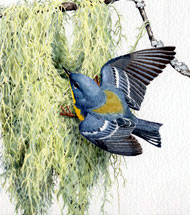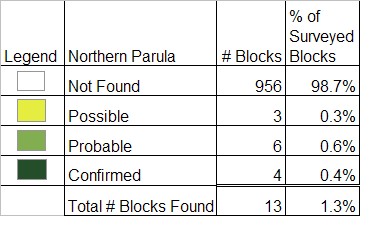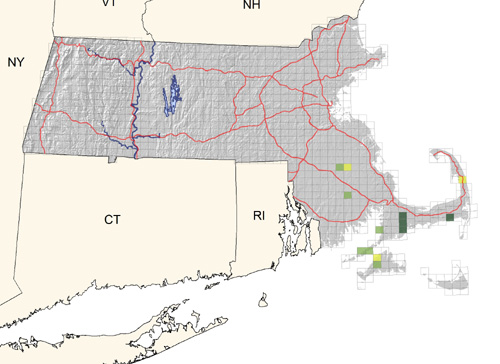Breeding Bird Atlases (BBA)
Find a Bird - BBA1
Breeding Bird Atlas 1 Species Accounts
Northern Parula
Parula americana
State Status
Threatened
Egg Dates
May 20 to July 7
Number of Broods
one; sometimes two

This diminutive warbler is a regular spring and fall migrant throughout the state, but the number of local breeding pairs is decreasing. In the late 1800s and early 1900s, the Northern Parula was a common breeder in Bristol County and parts of Cape Cod and nested locally in other areas of eastern Massachusetts. Loss of habitat from development and the creation of cranberry bogs contributed to the decline. Another factor was the unexplained disappearance of old man’s beard lichen, which seems to be a requisite for nesting in many sections of the state.
During the Atlas period, nesting was confirmed only along the Mashpee River and in the Harwich marshes on Cape Cod. A few other possible sites were in Plymouth County and on Martha’s Vineyard and the Elizabeth Islands. Much of the area bordering the Mashpee River has suffered encroachment by homes, roads, and developments. An incomparably rich estuary and waterway has been reduced to a tattered remnant of its former self. What remains is still probably the best place in Massachusetts to look for this smallest of all eastern warblers during the nesting season.
The first spring migrants appear in late April and early May in a variety of habitats but seem to prefer wet areas near bogs or streams or along rivers and swamps. They often frequent one of the larger trees, maybe an oak putting out tassels, high up and difficult to spot, the males singing sporadically. Often, an individual will remain in the same tree for an hour or more, busily pursuing small insects and in no hurry to fly farther on. Birch, Pitch Pine, and even cedar may harbor the inchworms and grubs that parulas prefer as food. Northbound migrants continue to pass through during May, with the last stragglers continuing even into early June.
The thin, wheezy, and ascending song is more buzz than trill and usually ends, after a slight crescendo, quite abruptly, as if cut off with a snap. Variations on this vocalization, heard during the nesting season, retain the same unmusical buzzy quality. In common with most species of warblers, the Northern Parula has several call notes. A chip similar to that of the Yellow Warbler is given and also a high thin sip note.
Little has been recorded about territory establishment or courtship in this species. Gray-green, feathery lichen commonly known as old man’s beard is the preferred nesting material of the parula. Where this lichen is found, this warbler may nest, especially if the area is moist. Both the lichen and the parula have been declining in many parts of the Northeast for much of the twentieth century. In Bristol County, many nests were formerly found in neglected orchards where apple trees were festooned with old man’s beard. In such places, nests were placed from 5 to 15 feet above the ground. Other nests were built in dense Atlantic White Cedar swamps, and also in Red Cedars. Along the edges of ponds, swamps, and streams, the nests were in a variety of trees at heights sometimes exceeding 20 feet (ACB). There is one historical record of a nest in Dartmouth in an oak that was built atypically of grass and just a covering of old man’s beard (EHF). Another nest in an Eastern Hemlock near Cambridge, where the lichen was scarce, was a more typical nest, the birds having managed to gather enough of the material for construction (ACB). On Cape Cod, nests have been found in maples, oaks, and pines.
The nest is usually a hanging basket of lichen with a side door. It may be unlined or contain small amounts of fine grass, hair, pine needles, or plant down. Four or five white eggs dotted with brownish spots are the norm. Clutch sizes for 11 Massachusetts nests were two eggs (1 nest), 3 eggs (3 nests), four eggs (7 nests) (DKW). Although there are reports that males may assist in incubation, this task is basically performed by the fe- male for 12 to 14 days. The young fledge about 10 or 11 days after hatching and are fed by both adults. In 1977, a female on the Cape was seen feeding a cowbird fledgling. Males sing well into July, and some pairs are apparently double brooded. Young birds and females may be confusing to iden-tify but share with the male a greenish yellow patch between the scapulars and extending a short way down the back—hence the old name of “Blue Yellow-backed Warbler.”
Fall migrants may appear in late July, but most of the movement occurs from late August through September. Records for October are not uncommon, and there are some reports even through early November. The species winters from Florida south through the West Indies, Mexico, and Central America.
The Northern Parula is listed as a threatened species in Massachusetts.
Map Legend and Data Summary
Atlas 1 data collected from 1975-1979


Note: rare and local in the southeastern region; possibly declining
Robert Pease



